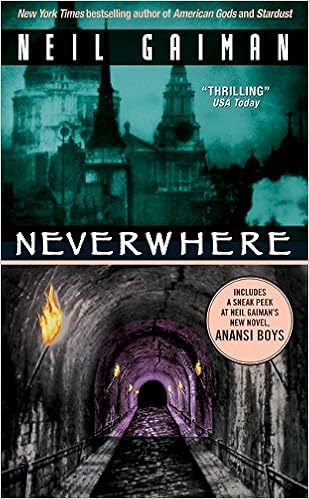
Free Downloads Neverwhere

Richard Mayhew is a plain man with a good heart -- and an ordinary life that is changed forever on a day he stops to help a girl he finds bleeding on a London sidewalk. From that moment forward he is propelled into a world he never dreamed existed -- a dark subculture flourish in abandoned subway stations and sewer tunnels below the city -- a world far stranger and more dangerous than the only one he has ever known...Richard Mayhew is a young businessman with a good heart and a dull job. When he stops one day to help a girl he finds bleeding on a London sidewalk, his life is forever altered, for he finds himself propelled into an alternate reality that exists in a subterranean labyrinth of sewer canals and abandoned subway stations below the city. He has fallen through the cracks of reality and has landed somewhere different, somewhere that is Neverwhere.

Mass Market Paperback: 400 pages
Publisher: Avon; Reprint edition (November 1, 1998)
Language: English
ISBN-10: 9780380789016
ISBN-13: 978-0380789016
ASIN: 0380789019
Product Dimensions: 4.2 x 1 x 6.8 inches
Shipping Weight: 4 ounces (View shipping rates and policies)
Average Customer Review: 4.4 out of 5 stars See all reviews (1,857 customer reviews)
Best Sellers Rank: #20,288 in Books (See Top 100 in Books) #3 in Books > Literature & Fiction > British & Irish > Horror #916 in Books > Literature & Fiction > Contemporary #1179 in Books > Literature & Fiction > Genre Fiction > Horror

Before he broke out full time into the world of novel writing Gaiman's reputation mostly rested on a relative handful number of comic books he had written, most notably (though not his best stuff) The Sandman series which showed his ability to toy with fantasy and myth to a near demented degree previously not expected for comic books. At best it was flat out amazing, at worst it was merely pleasant. Name recognition alone probably drove a lot of Gaiman starved Sandman fans to this book but fortunately it has much broader appeal as a contemporary fantasy. In this tale normal guy Richard Mayhew helps a stranger and winds up falling through the cracks into "London Below" a quasi-mystical world that coexists and yet can't be seen by "London Above". Now Richard, with a bizarre cast of comrades has to help the lady Door figure out how killed her family and what it all means, while dodging all sorts of unpleasantness that keeps popping up. The idea of a fantastic dark London overlapping the normal London isn't anything new (DC Comics' Hellblazer went over that concept all the time and "Midnight Nation" applies it to the entire US) but the key to a story like this is imagination which Gaiman has in spades. Every texture of the London Below feels real, and almost every page has some bizarre occurance or some off kilter social commentary disguised as fantasy coming from all sides. He has more good ideas than any man should possibly have and these ideas and his brilliant descriptions are what carry the novel, for the most part, you can read the whole thing like a travelogue and just become immersed in this strange and amazing world.
In the field of Science-Fiction/Fantasy, there is no greater accomplishment than creating a unique and intriguing universe. Although well-written books, The Hobbit and Foundation are classics less for perfect prose than for the creatures, landscapes and societies they introduced. The appeal of the universe ranges outside books, though. It is why Attack of the Clones grossed millions on its opening day and why a lot of people know more about Marvel Comics than they do about any foreign country.Neverwhere by Neil Gaiman is a pretty unmistakable attempt at creating a universe. The novel was Gaiman's first major project after finishing the acclaimed Sandman comic series (which could be described as his first universe, but is more of an amalgamation of Biblical scripture, Gaelic and other folk tales and the larger world of DC Comics). Because of Sandman's success, Gaiman is sometimes considered a new Tolkien or Asimov, but he fails to reach his potential on Neverwhere because, despite his ambition, his universe-creating powers at not at a prime.The universe of this novel is London Below, a dark and outlandish world existing beneath the UK's sprawling capital. It is inhabited by a feudal aristocracy, lonesome warriors and a religious cult that talks to rats. After two ruthless mercenaries slaughter one of London Below's most prominent families, the only survivor, a young woman named Door (for her ability to open mystic gates), escapes to London Above, where reluctant yuppie Richard Mayhew takes her in. Joined by the mordant Marquis de Carabas and a grim female bodyguard called (get this) Hunter, Richard and Door journey through London Below to find-out who ordered the deaths of Door's family and why.
Neverwhere Neverwhere [Adaptation] Neverwhere Low Price CD Neverwhere: A BBC Radio Full-Cast Dramatisation



